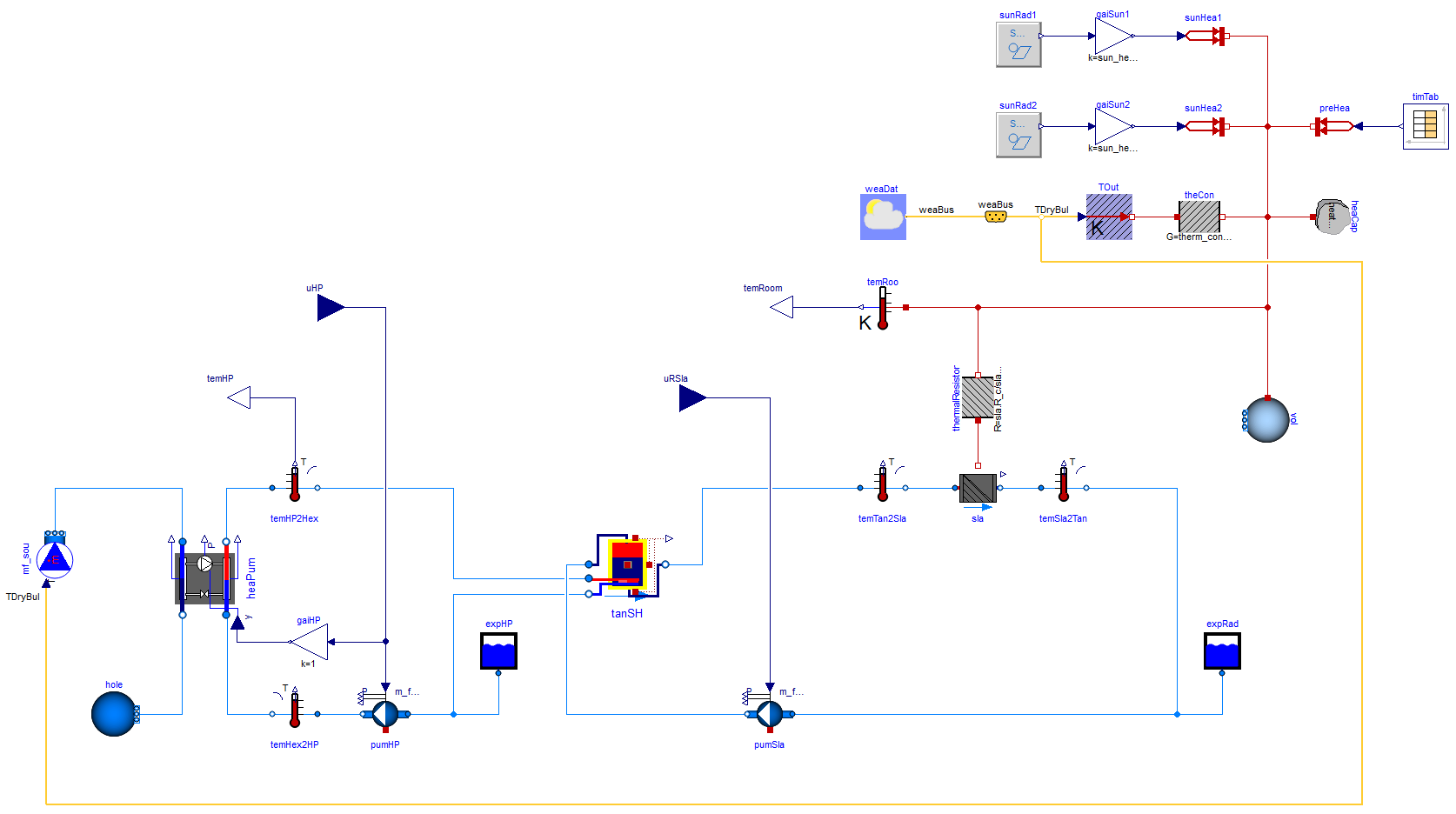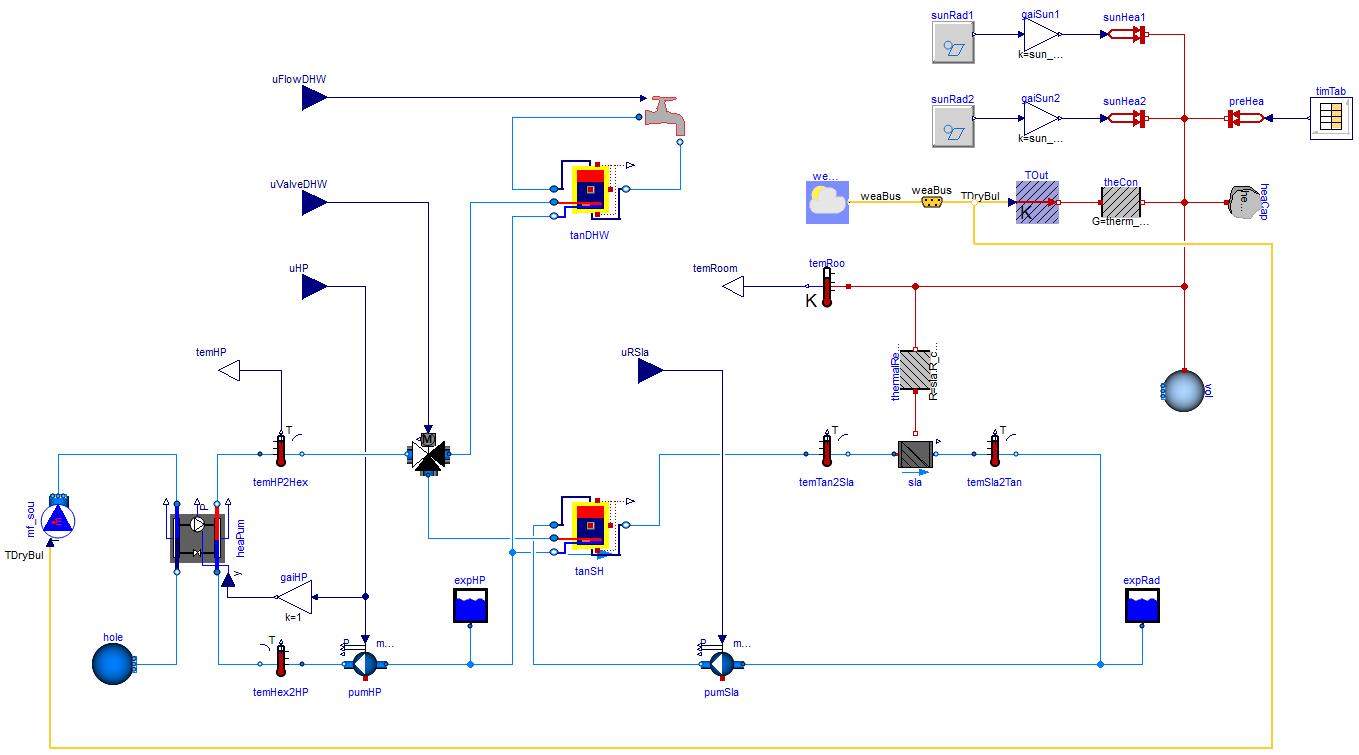SwissHouseRSlaTank¶
The SwissHouse building is a one-zone residential building located in Zurich Canton, Switzerland.
Building and thermal zones¶
The entire house is modeled with a single thermal zone. Its envelop is a simple RC model with R, C parameters fitted to a real swiss Minergie house (low energy consumption building standard).
Thermal systems¶
Heat is provided by a water to water heat pump, connected to a tank. The tanks serves as a supply to the hydronic underfloor heating. In the version SwissHouseRSlaTankDhw-v0, a hot water tank for hot water consumption is added and connected to the pump as well. The building has no cooling system.
The picture below displays the SwissHouseRSlaTank systems.

The picture below displays the SwissHouseRSlaTankDhw systems.

Electrical systems¶
The site incorporates a photovoltaic installation.
Controllable components¶
HP control¶
The heat pump normalized power is controllable.
Tank control¶
The normalized flow from the tank to the room is controllable.
Valve control¶
The valve opening (water flow to the hot water tank) is controllable. This is only the case for the moder with hot water tank.
Simulation inputs¶
For more detail, please check the documentation The SwissHouse environment or the source code in energym.envs.swiss_house.swiss_house.SwissHouse.
Variable Name |
Type |
Lower Bound |
Upper Bound |
# States |
Description |
|---|---|---|---|---|---|
uHP |
scalar |
0 |
1 |
Heat pump power fraction setpoint. |
|
uRSla |
scalar |
0 |
1 |
Hot water emitter flow fraction setpoint. |
|
uValveDHW |
scalar |
0 |
1 |
Hot water valve opening fraction. |
|
uFlowDHW |
scalar |
0 |
1 |
Hot water flow demand fraction. |
Simulation outputs¶
Variable Name |
Type |
Lower Bound |
Upper Bound |
# States |
Description |
|---|---|---|---|---|---|
weaBus.HDifHor |
scalar |
0 |
1000 |
Horizontal diffuse solar radiation (W/m2). |
|
weaBus.HDirNor |
scalar |
0 |
1000 |
Direct normal radiation (W/m2). |
|
weaBus.HGloHor |
scalar |
0 |
1000 |
Horizontal global radiation (W/m2). |
|
weaBus.HHorIR |
scalar |
0 |
1000 |
Horizontal infrared radiation (W/m2). |
|
sunRad.y |
scalar |
0 |
1000 |
Direct normal radiation (W/m2). |
|
sunHea.Q_flow |
scalar |
0 |
100 |
Solar heat flow rate (W). |
|
preHea.Q_flow |
scalar |
0 |
100 |
Prescribed heat flow rate (W). |
|
heaPum.P |
scalar |
0 |
100 |
Heat pump consumed power (W). |
|
heaPum.QCon_flow |
scalar |
0 |
100 |
Actual heating heat flow rate added to fluid (W). |
|
heaPum.QEva_flow |
scalar |
0 |
100 |
Actual cooling heat flow rate removed from fluid (W). |
|
heaPum.COP |
scalar |
0 |
20 |
Heat pump coefficient of performance. |
|
heaPum.COPCar |
scalar |
0 |
20 |
Heat pump Carnot efficiency. |
|
heaPum.TConAct |
scalar |
273.15 |
343.15 |
Condenser temperature used to compute efficiency (K). |
|
heaPum.TEvaAct |
scalar |
273.15 |
343.15 |
Evaporator temperature used to compute efficiency (K). |
|
tanSH.heaPorSid.T |
scalar |
273.15 |
353.15 |
Tank temperature (K). |
|
sla.QTot |
scalar |
0 |
100 |
Slab heat flow rate (W). |
|
sla.m_flow |
scalar |
0 |
10 |
Slab mass flow rate (kg/s). |
|
sla.heatPortEmb[1].T |
scalar |
273.15 |
343.15 |
Slab temperature (K). |
|
temRet.T |
scalar |
273.15 |
353.15 |
Heat pump return temperature (K). |
|
temSup.T |
scalar |
273.15 |
353.15 |
Heat pump supply temperature (K). |
|
TOut.T |
scalar |
253.15 |
343.15 |
Outdoor temperature (K). |
|
temRoo.T |
scalar |
263.15 |
343.15 |
Indoor temperature (K). |
|
y |
scalar |
263.15 |
343.15 |
Indoor temperature (K). |
Weather files¶
The available weather files for this model have the following specifiers:
CH_ZH_Maur(Evaluation file)CH_BS_Basel(Default)CH_TI_BellinzonaCH_GR_DavosCH_GE_GenevaCH_VD_Lausanne
Evaluation scenario¶
The evaluation scenario for the SwissHouseRSlaTank-v0 model consists of a control from January to April with the objective of minimizing the power demand, while keeping the zone temperatures between 19 and 24°C. For this goal, the tracked KPIs are the average power demand, and the average temperature deviation and total temperature violations with respect to the interval [19, 24]. For the model with hot water consumption, there is no prescribed consumption flow fraction rate yet, and the user can choose/ implement typical hot water consumption patterns.
Notebook example¶
Here is a notebook example: